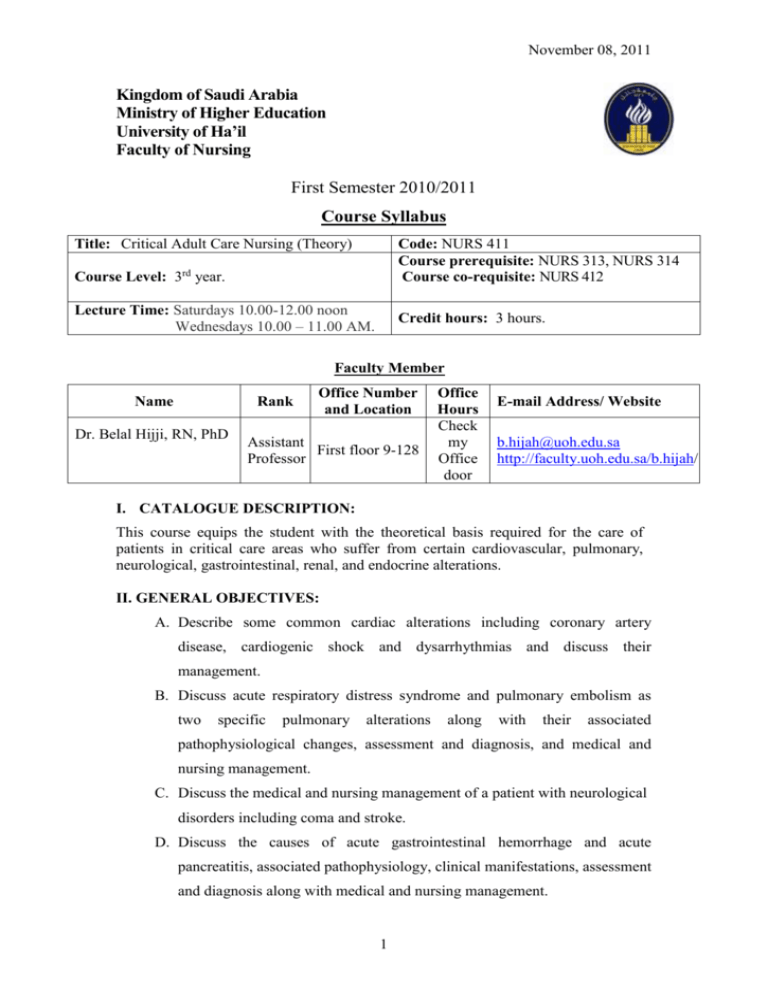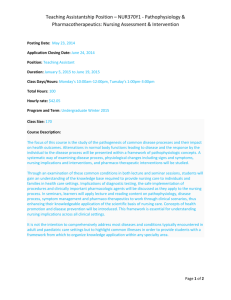November 08, 2011 Kingdom of Saudi Arabia Ministry of Higher
advertisement

November 08, 2011 Kingdom of Saudi Arabia Ministry of Higher Education University of Ha’il Faculty of Nursing First Semester 2010/2011 Course Syllabus Title: Critical Adult Care Nursing (Theory) Code: NURS 411 Course prerequisite: NURS 313, NURS 314 Course co-requisite: NURS 412 Course Level: 3rd year. Lecture Time: Saturdays 10.00-12.00 noon Wednesdays 10.00 – 11.00 AM. Credit hours: 3 hours. Faculty Member Name Rank Dr. Belal Hijji, RN, PhD Office Number and Location Assistant First floor 9-128 Professor Office Hours Check my Office door E-mail Address/ Website b.hijah@uoh.edu.sa http://faculty.uoh.edu.sa/b.hijah/ I. CATALOGUE DESCRIPTION: This course equips the student with the theoretical basis required for the care of patients in critical care areas who suffer from certain cardiovascular, pulmonary, neurological, gastrointestinal, renal, and endocrine alterations. II. GENERAL OBJECTIVES: A. Describe some common cardiac alterations including coronary artery disease, cardiogenic shock and dysarrhythmias and discuss their management. B. Discuss acute respiratory distress syndrome and pulmonary embolism as two specific pulmonary alterations along with their associated pathophysiological changes, assessment and diagnosis, and medical and nursing management. C. Discuss the medical and nursing management of a patient with neurological disorders including coma and stroke. D. Discuss the causes of acute gastrointestinal hemorrhage and acute pancreatitis, associated pathophysiology, clinical manifestations, assessment and diagnosis along with medical and nursing management. 1 November 08, 2011 E. Explain the common causes of acute tubular necrosis (ATN), its pathophysiology and phases, risk factors for its development, and various aspects of its medical and nursing management. F. Discuss neuroendocrine response to acute and prolonged critical illness. G. Describe medical and nursing management of hyperglycemia and hypoglycaemia. H. Discuss the various aspects related to diabetic ketoacidosis (DKA) and hyperglycaemic hyperosmolar state (HHS). III. INSTRUCTIONAL MATERIALS: Urden, N.; Stacy, K. and Lough, M. (2010). Critical Care Nursing: Diagnosis and Management. 6th edition. Mosby: St. Louis, Missouri. IV. COURSE OUTLINE*: Date Unit Title Contents 28.09 - 22.10 UNIT 1: CARDIOVASCULAR ALTERATIONS 26.10 – 29.10 UNIT 2: PULMONARY ALTERATIONS 31.10 – 11.11 12.11 UNIT 3: NEUROLOGICAL ALTERATIONS 16.11.11 19.11 – 23.11 26.11 – 30.11 UNIT 4: GASTROINTESTINAL ALTERATIONS 03.12.11 07.12 UNIT 5: ALTERATIONS UNIT 6: ENDOCRINE 17.12 – 21.12 ALTERATIONS 10.12 – 14.12 RENAL Coronary Artery Disease Cardiogenic Shock Dysarrhythmias Acute Respiratory Distress Syndrome Pulmonary Embolism Eid Al Adha Holiday Coma First Examination Stroke Acute gastrointestinal hemorrhage Acute pancreatitis Second Examination Acute pancreatitis (Continued…) Acute tubular necrosis Neuroendocrinology of stress and critical illness Diabetes ketoacidosis (DKA) DKA (Continued…) Hyperglycemic hyperosmolar state (HHS) 24.12 –28.12 31.12.11 – 12/1/2012 Final Examinations *NOTE: The above information is a general outline of the material covered. The Faculty member reserves the right to alter the material either by adding or deleting as conditions and time allows. 2 November 08, 2011 V. SPECIFIC UNIT THEORY BEHAVIOURAL OBJECTIVES: Upon the completion of these units, the student will: Unit I: Cardiovascular Alterations 1. Provide brief description of CAD and its etiology. 2. Discuss the risk factors for the development of CAD and describe its pathophysiology. 3. Define unstable angina, recognise its medical and nursing management. 4. Define MI and describe its pathophysiology in brief. 5. Discuss the medical and nursing management of patient with acute MI. 6. Provide a brief description of the cardiogenic shock, its etiology, and its pathophysiology. 7. Identify the clinical manifestations of cardiogenic shock. 8. Discuss the medical and nursing management of a patient with cardiogenic shock. 9. Describe the normal electrical conduction of the heart. 10. Discuss the characteristics of various types of sinus node and ventricular dysarrhythmias. 11. Describe the nursing management of a patient with dysarrhythmias. Unit II: Pulmonary Alterations 1. Define acute respiratory distress syndrome (ARDS), describe its pathophysiology and clinical manifestations. 2. Discuss the process of assessment and diagnostic findings of ARDS. 3. Discuss the medical and nursing management of ARDS. 4. Describe pulmonary embolism (PE), its pathophysiological changes, and discuss its clinical manifestations. 5. Identify the diagnostic test that may be used to diagnose PE. 6. Discuss the medical and nursing management of PE. Unit III: Neurological Alterations 1. 2. 3. 4. 5. 6. Describe what coma is, identify its causes, and discuss its pathophysiology. Discuss assessment and clinical diagnosis of coma and vegetative state. Describe the medical and nursing management of coma. Briefly describe what stroke is and its incidence. Differentiate between ischaemic and hemorrhagic stroke. Discuss the etiology, pathophysiology, assessment and diagnosis, and medical management of both ischemic and hemorrhagic stroke. 7. Discuss the nursing management of a patient with stroke. 3 November 08, 2011 Unit IV: Gastrointestinal Alterations. 1. Discuss the main causes of gastrointestinal bleeding that are seen in the intensive care unit (ICU). 2. Briefly describe the pathophysiology, assessment and diagnosis, and medical management of gastrointestinal bleeding. 3. Discuss the nursing management of a patient with gastrointestinal bleeding. 4. Define acute pancreatitis, identify its causes, and describe the pathophysiological changes associated with it. 5. Discuss assessment and diagnosis of acute pancreatitis along with its medical management. 6. Discuss the various aspects of nursing management of a patient with acute pancreatitis Unit V: Renal Alterations 1. Explain the common causes of acute tubular necrosis (ATN) and its pathophysiology. 2. Identify the four phases of ATN and their characteristics. 3. Discuss assessment and diagnostic findings of ATN. 4. Identify disease states that increase the risk of ATN. 5. Discuss the importance of hemodynamic monitoring and fluid balance in a patient with ATN. 6. Discuss the medical, pharmacological, and nutritional management of ATN. 7. Discuss the nursing management of a patient with ATN. Unit VI: Endocrine Alterations 1. 2. 3. 4. Describe the neuroendcrinology of stress and critical illness. Discuss neuroendocrine response to acute and prolonged critical illness. Identify the causes of adrenal gland dysfunction. Describe hyperglycemia and blood glucose management in critically ill patients. 5. Discuss insulin and hypoglycemia management in critically ill patients. 6. Discuss nursing management of a patient with neuroendocrine stress resulting from critical illness. 7. Identify the diagnostic criteria for, and etiology of, diabetic ketoacidosis (DKA). 8. Discuss the pathophysiology and assessment and diagnostic findings of DKA. 9. Discuss the medical and nursing management of DKA. 10. Describe hyperglycemic hyperosmolar state (HHS) and identify its diagnostic criteria. 11. Describe the pathophysiology of DKA along with its assessment and diagnostic findings. 12. Discuss the medical and nursing management of DKA. 4 November 08, 2011 VI. ATTENDANCE AND TARDY POLICY: CLASSROOM: Absence from lectures shall not exceed 20%. Students who exceed the 20% limit shall not be allowed to take the final examination and shall receive a mark of zero for the course. A student will be considered tardy if he/she comes into the classroom more than 10 minutes after the scheduled time. For each tardy, the student will lose 0.5 point. VII. CLASSROOM ETIQUETTE: An integral part of an education is developing a sense of integrity and responsibility, not only toward instructors, but also toward other students. In the classroom, demonstrating appropriate behaviour reflects on your maturity. Arriving late to class and inappropriate and talking while class is in progress negatively reflects on you and your fellow students. Always switch off your mobile before entering the classroom. Please be considerate. VIII. TEACHING METHODS: Lecture Group discussion IX. MODE of ASSESSMENT: Units of Evaluation Score First Exam 25 Points Second Exam 25 Points Classroom attendance 10 Points Final Exam 40 Points Total 100 Make-up exams will be offered for valid reasons only. Make-up exams may be different from regular exams in content and format. 5






